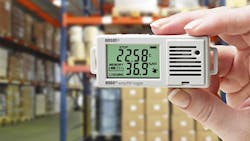Onset HOBO loggers can retain vitamin freshness
Recently a manufacturer of vitamins and mineral supplements deployed several Onset HOBO temperature and humidity loggers in its climate-controlled warehouse to monitor seasonal temperature fluctuations and optimize freshness.
To comply with FDA quality regulations and to meet its own internal PQ standards, the company has implemented a seasonal temperature profile program for its vitamin storage facilities throughout the country. Because many of its products are temperature- and humidity-sensitive, extreme weather can quickly compromise product quality.
Prior to this installation, the company had relied on a programmable sensor to track warehouse environmental conditions, but this was expensive and cumbersome. Looking for a more optimal solution, the engineering staff found Onset online and discovered the company’s line of HOBO UX100-003 Series temperature and humidity loggers.
The HOBO temperature/relative humidity data logger records both temperature and RH% (within 3.5% accuracy) in indoor environments using its internal sensors. The UX100-003 data logger is ideal for tracking food storage conditions in warehouses, logging temperature in server rooms, and measuring humidity levels in museums.
These matchbox-sized devices bridge the gap between traditional dataloggers, which are limited in accuracy and memory, and larger, more expensive data loggers that can be difficult to program and maintain. The logger’s built-in LCD screen makes it easy for warehouse workers to check current temperature and RH levels in real time, and also provides indicators for logging status, battery use, and memory consumption. The loggers work with Onset’s HOBOware software for graphing, analyzing and reporting environmental data.
In one warehouse temperature mapping project, engineers deployed multiple HOBO temperature and humidity data loggers in a 33,000-square-foot facility. Before installing the loggers, the staff tested their accuracy by putting them in an environmental chamber, plugging them in, setting temperature and humidity ranges, and then monitoring to make sure the loggers stayed within those ranges.
Having passed the accuracy verification test, the loggers were configured using their HOBOware software to measure and record temperature and humidity levels every 30 minutes on a 24/7 basis. Users also set alarm notifications so warehouse staff can be immediately notified of problems.
In this particular project, users deployed the HOBO loggers in a vertical, column-like fashion at three different heights in the 30-ft-high storage area. Loggers were placed at the top (25 feet), middle (15 feet), and bottom (1 foot) of storage racks, and, where possible, mounted near air supply and returns. Environmental data were logged for a period of three weeks and then offloaded via USB to an office PC for analysis.
At the end of the three-week monitoring period, staff engineers used collected data to create detailed graphs of the temperature/humidity profiles and incorporate them into slide presentations to update the company’s management. These reports and visuals will help the engineering team to make ongoing recommendations on possible issues.
If any building system changes are made, the engineering team can map the environmental conditions for another three weeks, using qualification documents to track the process.
For further information, see www.DataLoggerInc.com or call 800-956-4437.
